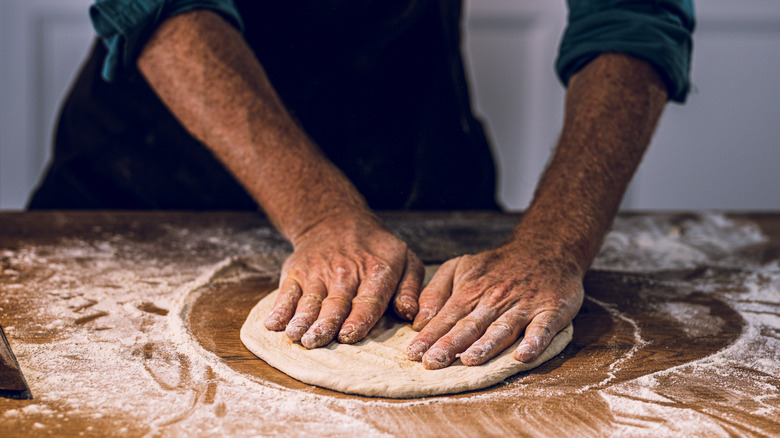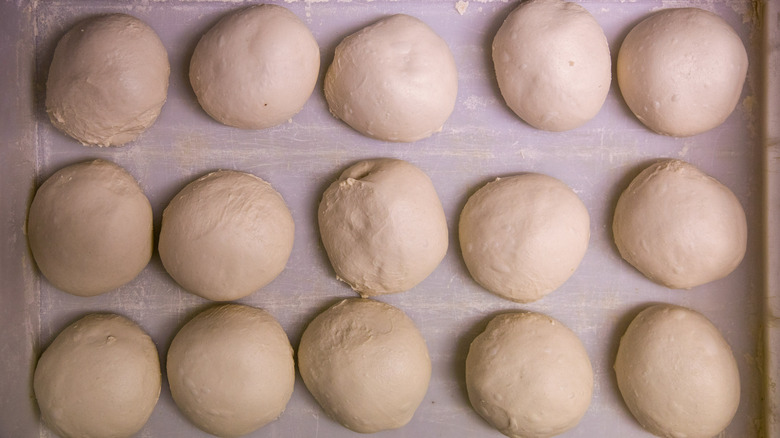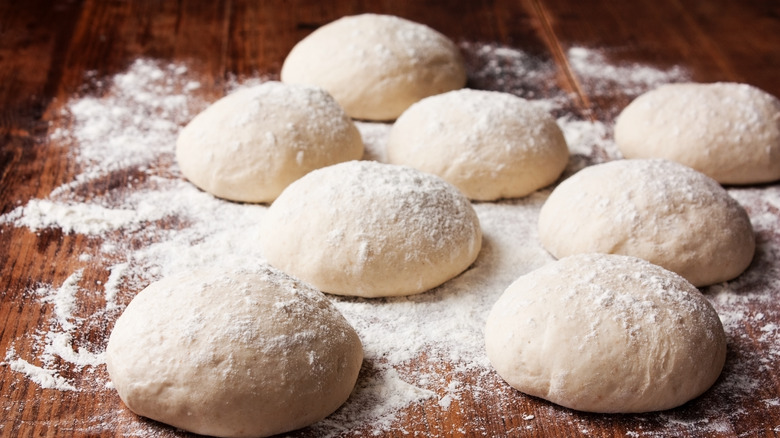What Does It Mean To Cold Ferment Pizza Dough?
If you've ever wondered how your local pizzeria has such a flavorful crust that's bubbly and not too charred, the answer is fermentation. Fermentation is essential for building flavor and structure in many foods, not just pizza and sourdough breads. Pickles, kimchi, sauerkraut, and kombucha all benefit from the flavor-building benefits of fermentation.
Most home cooks and bakers who dabble in the art of yeast know the general steps when assembling a dough: mix, knead, first rise, shape, second rise, and bake. And we usually do it all in one day — a Pullman bread recipe only requires an hour and a half of total proof time. Sure, some of us may be using an easy no-knead recipe that spends all day getting puffier before baking, but we're not taking advantage of the best flavor builders: time and temperature.
There's a reason people like a slice of sourdough bread or a Neapolitan pizza crust, and that's the taste: Deeply flavorful, tangy, slightly acidic, and a texture and structure you can't get from just a few hours' rise. This is where cold fermentation comes in, which allows the time required to build those super complex flavors. It's achievable at home: All you need is some space in your refrigerator.
How does cold fermentation benefit pizza dough?
When dough is warm, yeast works hard to feed on the starches and sugars in the flour. The byproduct is carbon dioxide, which forms the bubbles – and other flavors — in pizza dough. This usually happens faster at higher temperatures. However, this doesn't translate into the best flavor. Instead of bready, yeasty flavors, the pizza dough will taste sour and floury, and won't be as complex.
Cold fermentation slows this process down to give the yeast a chance to produce more desirable flavors. The yeast has time to work and build those complex flavors. Think of how long you need to wait for fermented foods like pickles or sauerkraut to be ready — the same idea applies to cold-fermented pizza dough. The pizza crust will be able to stand up in its own right to whatever toppings you've chosen.
A side benefit to cold fermentation, besides improved flavor, is better internal structure. The longer the dough is left to work on its own, the more chance there is for the gluten proteins to relax and form that precious network. The result is bigger bubbles and an airy crust when baked. Plus, cold fermentation is ideal for fitting bread baking into your busy schedule because you can leave it in the refrigerator for the last rise and bake it when you get home.
There is a time limit on how long you can cold ferment your pizza dough
If you're ready to jump into cold fermentation, clear some space in your refrigerator. After mixing and kneading or doing the lift and fold method to build some gluten, you can do the first rise — or bulk fermentation — on your countertop. Once you've shaped your pizza dough, it's time to proof your bread in the refrigerator. If you have a proofing container you can use it here. Leave the dough in the refrigerator for 72 hours, or around three days, then proceed as usual with your pizza.
Anything longer than two or three days and you risk overproofing your dough, which will rise and then promptly fall when baked, giving you a flat, dense pizza crust. The dough will also start to produce some pretty funky, off-putting flavors. This is because the yeast eventually stops producing the good stuff and instead produces alcohol, which kills off the yeast and causes some really sour flavors. If you've ever sniffed an underfed or neglected sourdough starter, you'll be familiar with the smell.
You can cold ferment any yeasted dough, but the results will vary based on a few factors, such as how much yeast is present, the temperature of your refrigerator, and the hydration percentage of your dough. If you find it worth your time, you can experiment with different ratios of ingredients, time, and temperatures to achieve your preferred results.


